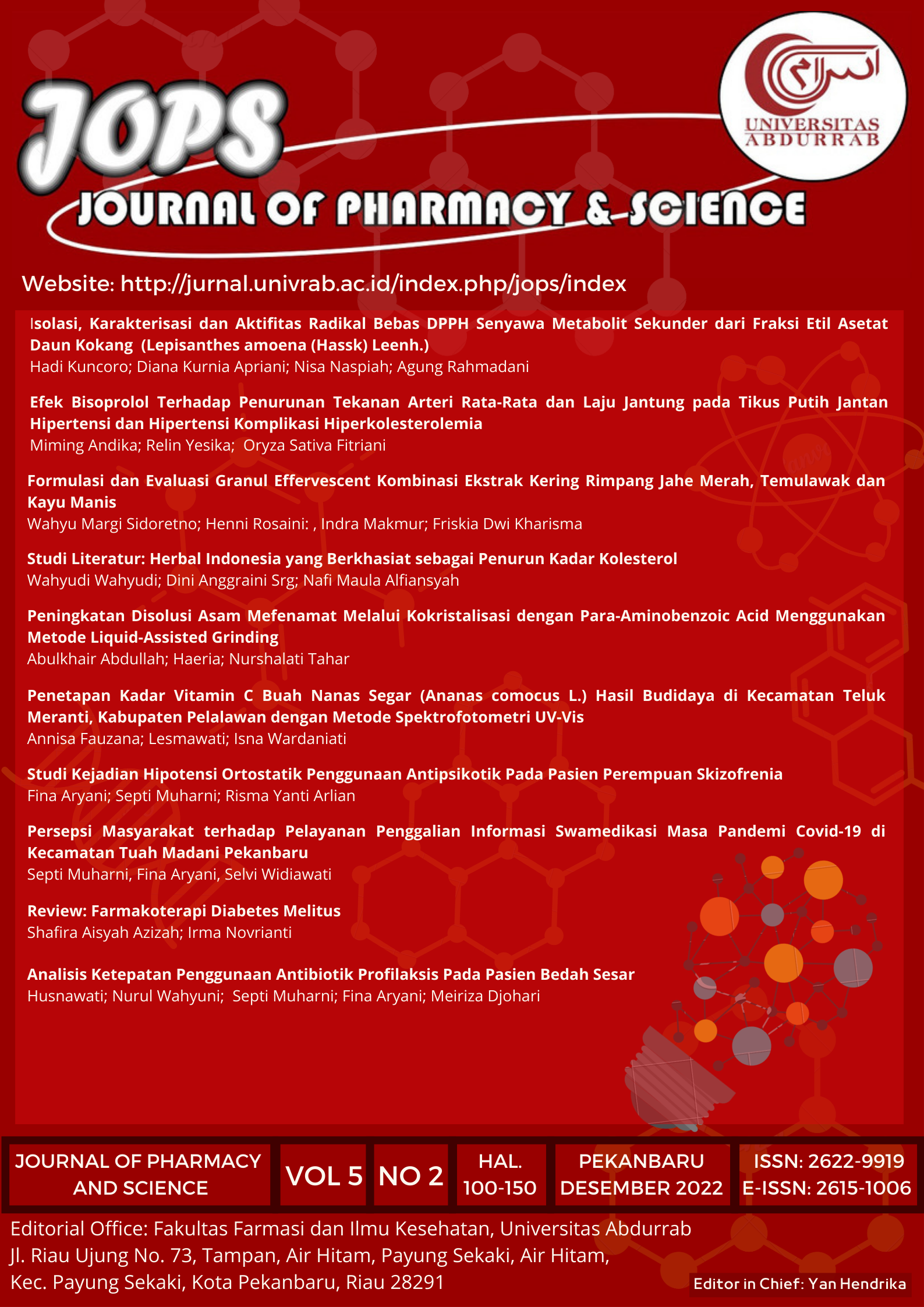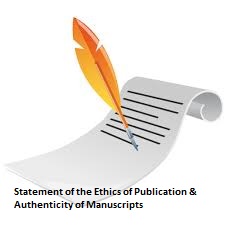Formulation and Evalution of Effervescent Granules Combination Extract Red Ginger, Curcuma and Cinnamon
DOI:
https://doi.org/10.36341/jops.v5i2.2461Keywords:
Effervscent, red ginger, curcuma, cinnamonAbstract
Effervescent granules are coarse to very coarse powders containing medicinal elements in a dry mixture. It’s consist of sodium bicarbonate, citric acid, and tartaric acid when added to water, the acid and base react to liberate carbon dioxide to produce foam. Effervescent can produce a pleasant taste due to the presence of carbonates which can help improve the taste of certain drugs. This objective of this study is to determine mixture of dry red ginger rhizome extract, curcuma and cinnamon’s effervescent granules and meets the criteria for good effervescent granules. The method on this study used wet granulation with four formula variations, namely F1: ordinary granules, F2: effervescent granules without active substances, F3 and F4 were effervescent granules with variations in acid and base. Evaluation of the physical quality of granules includes water content test, compressibility test, flow time test, angle of repose, liquid absorption test, Scanning Electron Microscope (SEM), dispersion time and pH. Based on the experimental results, the combination of dry red ginger rhizome extract, curcuma and cinnamon can be formulated into effervescent granules. The preparation of effervescent granules combined with dry extract of red ginger rhizome, curcuma and cinnamon did not meet the criteria for a good effervescent granule, namely the water content test of the granules F2, F3, F4 each obtained 6.47±0.07, 6.61±0.03, and 5.82±0.04% where the range of good granule moisture content is 2-5%.
Downloads
References
Ansel, H.C.(1989). Pengantar Bentuk Sediaan Farmasi Diterjemahkan Oleh Ibrahim.F. (Edisi Keempat). Jakarta: Universitas Indonesia Press.
Ansel, H.C., Popovich,N.G., Allen.,L.V. (2011). Pharmaceutical Dosage Form and Drug Delivery System Ninth Edition. London: New York.
Aulton, M.E. (1988). Pharmaceutics: The Science of Dosage Form Design: Health Science Book. New York: Churchill Livingstone.
Aryanta, I.W.R. (2019). Manfaat Jahe Untuk Kesehatan. E.Jurnal Widya Kesehatan. 1(2).
Departemen Kesehatan Republik Indonesia. (2000). Parameter Standar Umum Ekstrak Tumbuhan Obat. Jakarta : Direktoral Jendral Pengawan Obat dan Makanan.
Departemen Kesehatan Republik Indonesia, (2008). Farmakope Herbal Indonesia edisi I. Jakarta: Departemen Kesehatan Republik Indonesia.
Hakim, L. (2015). Rempah & Herba Kebun-Pekarangan Rumah Masyarakat. Yogyakarta: Diandra Creative.
Halim, A. (2012). Farmasi Fisika Pulva Engginering. Padang: Andalas University Press
Hasan, F., Murwani, S., Indrati, R. (2014). Efek Imunostimulator Ekstrak Etanol Kayu Manis (Cinnamomum burmannii) terhadap Peningkatan Jumlah Sel T CD4 dan T CD8 pada Mencit BALB/C. (Disertasi). Malang: Universitas Brawijaya.
Kementerian Kesehatan Republik Indonesia. (1994). Keputusan Menteri Kesehatan Republik Indonesia Nomor: 661/Menkes/SK/VII/1994 Tentang Persyaratan Obat Tradisional. Jakarta : Kementerian Kesehatan
Kholidah, S, Yuliet, Khumaidi, A. (2014). Formulasi Tablet Effervescent Jahe (Z Officinale Roscoe) Dengan Variasi Konsentrasi Sumber Asam Dan Basa. Online Jurnal Of Natural Science, Vol. 3(3): 216 - 229 ISSN: 2338-0950.
Lachman, L., & Lieberman, H. A. (1994). Teori dan Praktek Farmasi Industri, Edisi Kedua, 1091-1098, UI Press, Jakarta.
Lachman. L., Lieberman, H.A.,Schwartz, J. B.(2008). (Terjemahan), Teori dan Praktek Farmasi Industri. Volume 1. New York: Marcel Dekker Inc.
Pramono, Y. B., & Nurwantoro, N. (2019). Evaluasi Kadar Gula, Kadar Air, Kadar Asam dan pH pada Pembuatan Tablet Effervescent Buah Nangka. Jurnal Teknologi Pangan, 3(1), 36-41.
Rahmawati, I. F., Pribadi, P., & Hidayat, I. W. (2016). Formulasi Dan Evaluasi Granul Effervescent Ekstra .Daun Binahong (Anredera cordifolia (Tenore) Steen.). Jurnal Pharmaciana, 6(2), 139-147.
Sa’diah, S., Anwar, E., Jufri, M., Cahyaningsih, U. (2019). Perbandingan Ekstrak Jahe Merah (Zingiber Officinale Roscoe. Var. rubrum), Gingerol, Dan Shagaol Sebagai Anti Toksoplasma Terhadap Parasite Toxoplasma Gondii Secara n-Vitro. Jurnal Jamu Indonesia, 4(3), 93-102.
Siregar, C., & Wikarsa, S. (2010). Teknologi Farmasi Sediaan Tablet: Dasar-Dasar Praktek,. Jakarta: Penerbit Buku Kedokteran EGC.
Syofyan, Yanuarto T, Octavia, M. (2015). Pengaruh Kombinasi Magnesium Stearat dan Talkum sebagai Lubrikan terhadap Profil Disolusi Tablet Ibuprofen. Jurnal Sains Farmasi & Klinis, (2), 195-206
Vitanti, T. A. P., Kawiji., Nurhartadi. E. (2016). Pengaruh Metode Ekstraksi Oleoresin Temulawak (Curcuma xanthorrhiza Roxb.) Dengan Pengeringan Solar Dryer Terhadap Kadar Kurkuminoid, Total Fenol Dan Aktivitas Antioksidan. Jurnal Biofarmasi, 14 (1), 1-9.
Voight, R. (1994). Pengantar Teknologi Farmasi. Penerjemah: Soedani, N. Yogyakarta: Universitas Gajah Mada Press.
Zulharmitta, Z., Kasypiah, U., & Rivai, H. (2017). Pembuatan Dan Karakterisasi Ekstrak Kering Daun Jambu Biji (Psidium guajava L.). Jurnal Farmasi Higea, 4(2), 147-157
Downloads
Published
How to Cite
Issue
Section
License
1. Copyright of all journal manuscripts is held by the JOPS (Journal Of Pharmacy and Science)
2. Formal legal provisions to access digital articles of electronic journal are subject to the provision of the Creative Commons Attribution-ShareAlike license (CC BY-NC-SA), which means that JOPS (Journal Of Pharmacy and Science) is rightful to keep, transfer media/format, manage in the form of databases, maintain, and publish articles.
3. Published manuscripts both printed and electronic are open access for educational, research, and library purposes. Additiponally, the editorial board is not responsible for any violations of copyright law.
licensed under a Creative Commons Attribution-ShareAlike 4.0 International License.










